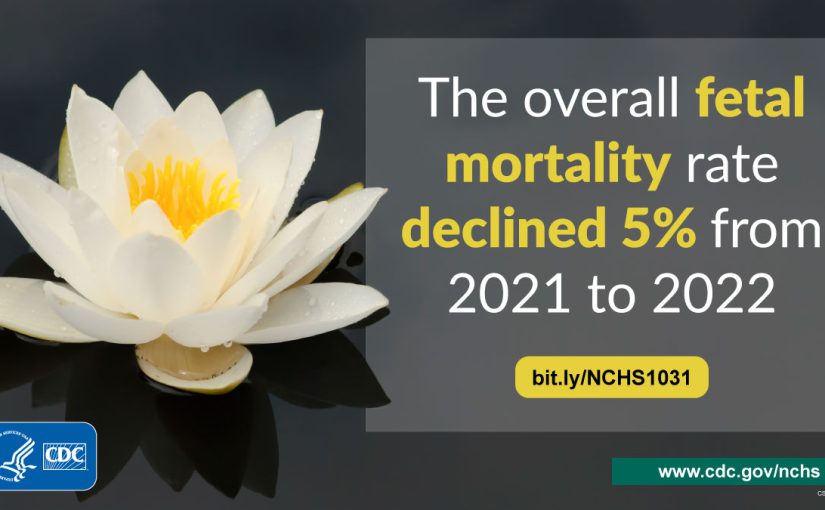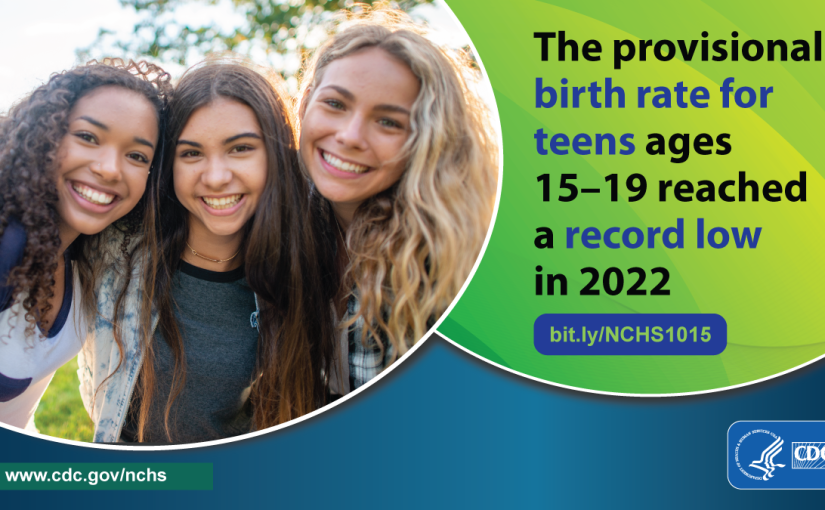Category: Reproductive Health
U.S. Fertility Rate Drops to Another Historic Low

The general fertility rate in the United States decreased by 3% from 2022, reaching a historic low. This marks the second consecutive year of decline, following a brief 1% increase from 2020 to 2021. From 2014 to 2020, the rate consistently decreased by 2% annually. These statistics and others from provisional 2023 birth data were Read More >
Posted on byFetal Mortality Declined 5% Between 2021 and 2022

According to analysis of data from the National Vital Statistics System, the overall fetal mortality rate in the United States declined 5% between 2021 and 2022, from 5.73 fetal deaths per 1,000 live births and fetal deaths to 5.45. The Vital Statistics Rapid Release, “Fetal Mortality in the United States: Final 2020-2021 and 2021-Provisional 2022” Read More >
Posted on byU.S. Teen Birth Rate Reached Another Historic Low in 2022

The teen birth rate in the United States decreased 3% from 2021, reaching a record low for this age group. The 2022 rates declined for both younger (ages 15–17) and older (ages 18–19) teenagers. The teen birth rate has declined every year except for two (2006 and 2007) since 1991. The new report, “Births: Provisional Read More >
Posted on byQuickStats: Percentage of Women Aged 22–44 Years Who Have Ever Cohabited with an Opposite-Sex Partner by Education
Among women aged 22–44 years, during 2015–2019, 67.3% had ever cohabited with an opposite-sex partner compared with 62.5% during 2006–2010. Among women with a high school diploma, GED, or less education, the percentages of those who had ever cohabited with an opposite-sex partner were similar (72.6%) across the two periods; the percentage of women with Read More >
Posted on byRacial and Ethnic Differences in Mortality Rate of Infants Born to Teen Mothers: United States, 2017–2018
Questions for Ashley Woodall, Health Statistician and Lead Author of “Racial and Ethnic Differences in Mortality Rate of Infants Born to Teen Mothers: United States, 2017–2018.” Q: Why did you decide to focus on teenagers for this report? AW: There has not been much research on infant mortality using national data that focuses on specific Read More >
Posted on byBirths: Final Data for 2018
Questions for Joyce Martin, Health Statistician and Lead Author of “Births: Final Data for 2018” Q: What is new in this report from the 2018 provisional birth report? JM: In addition to providing final numbers and rates for numerous birth characteristics such as fertility rates, teen childbearing, cesarean delivery and preterm and low birthweight, this Read More >
Posted on byBirths: Provisional Data for 2018
Questions for Brady E. Hamilton, Ph.D., Demographer, Statistician, and Lead Author of “Births: Provisional Data for 2018.” Q: How does the provisional 2018 birth data compare to previous years? BH: The number of births, the general fertility rate, the total fertility rate, birth rates for women aged 15-34, the cesarean delivery rate and the low-risk Read More >
Posted on byFact or Fiction: Do women who live in rural counties in the U.S. give birth at an earlier age than women in large metropolitan counties?
http://www.youtube.com/watch?v=Fj-m4yjbsnE Source: National Vital Statistics System, 2017 https://www.cdc.gov/nchs/data/databriefs/db323-h.pdf Read More >
Posted on byBirths: Provisional Data for 2017
Questions for Brady E. Hamilton, Ph.D., Demographer, Statistician, and Lead Author of “Births: Provisional Data for 2017” Q: What did you think was the most interesting finding in your new analysis? BH: The report includes a number of very interesting findings. The general fertility rate, 60.2 births per 1,000 women aged 15–44, declining 3% in Read More >
Posted on byStat of the Day – June 21, 2017
#STATOFTHEDAY Females 15–17 w/confidentiality concerns less likely to get #ReproductiveHealthCare than those without https://t.co/jynWGO9oTz — NCHS (@NCHStats) June 21, 2017 Read More >
Posted on byBirths: Final Data for 2015
Questions for Joyce A. Martin, M.P.H., Demographer, Statistician, and Lead Author on “Births: Final Data for 2015” Q: Was there a result in your study’s analysis of births in the United States that you hadn’t expected and that really surprised you? JM: Although small, (from 9.57% to 9.63%) the rise in the preterm birth rate Read More >
Posted on byConfidentiality Concerns and Sexual and Reproductive Health Care Among Adolescents and Young Adults Aged 15–25
Confidentiality concerns can impact adolescent and young adults’ access to sexual and reproductive health services. Young people who are covered by their parents’ private health insurance may be deterred from obtaining these services due to concerns that their parents might find out about it. Similarly, confidentiality concerns may arise because youth seeking such services may Read More >
Posted on byProvisional Estimates of Birth Data for 2014 through the Second Quarter of 2016
NCHS has released provisional estimates of selected reproductive indicators from birth data for 2014 through the second quarter of 2016. Estimates for 2014 and 2015 are based on final data. The estimates for the first and second quarter of 2016 are based on all birth records received and processed by NCHS as of August 28, Read More >
Posted on byQuickStats: Gestational Weight Gain Among Women with Full-Term, Singleton Births, Compared with Recommendations — 48 States and the District of Columbia, 2015
Gestational weight gain was within the recommended range for 32% of women giving birth to full-term, singleton infants in 2015, with 48% gaining more weight and 21% less weight than recommended. Approximately 44% of women who were underweight before pregnancy gained within the recommendations, compared with 39% of women who were normal weight, 26% of Read More >
Posted on byWomen’s Contraception Reports
Two new reports released by the National Survey of Family Growth (NSFG) give insight into the use and methods of contraception among women aged 15-44. The first report, Use of Emergency Contraception Among Women Aged 15-44: United States, 2006-2010, focused on trends and variation in the use of emergency contraception and reasons for use among Read More >
Posted on by
